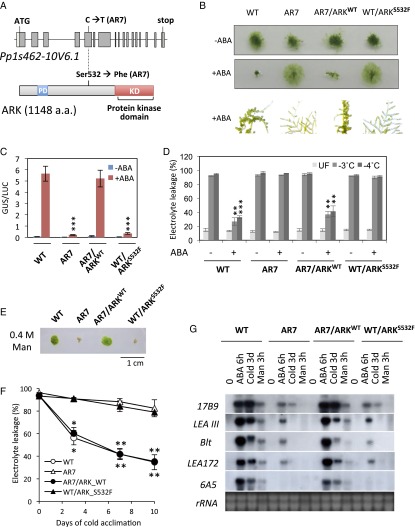Fig. 2.
Characterization of Pp1s462-10V6.1 of P. patens. (A) Structures of the Pp1s462-10V6.1 gene mutated in AR7 and the encoded protein ARK deduced from the sequence of the isolated cDNA (GenBank KT581394). The C-to-T transition in the fifth exon caused an amino acid change from Ser to Phe at position 532 N-terminal to the protein kinase domain (KD). PD indicates a putative PAS domain. (B) Growth of protonemata with or without ABA of WT, AR7, the AR7 knock-in line with the ARK sequence changed to that of WT (AR7/ARKWT), and the WT knock-in line with the ARK sequence changed to that of AR7 type (WT/ARKS532F). (C) Transient assays for detection of ABA-induced gene expression. The protonemata of the lines used in B were bombarded with the Em-GUS and Ubi-LUC constructs and incubated with or without 10 µM ABA for 1 d, followed by the GUS and LUC assays. Levels of gene expression are represented by GUS/LUC ratio. Error bars indicate the SE (n = 3). ***P < 0.01 compared with ABA-treated WT (t-test). (D) ABA-induced freezing tolerance of the lines used in B. Protonemata were treated for 1 d with 10 µM ABA and either were kept at 4 °C (UF) or were subjected to equilibrium freezing to −3 °C or −4 °C. Survival of the protonemata was estimated by measuring electrolyte leakage from the injured cells. Error bars indicate the SE (n = 3). ***P < 0.001 and **P < 0.01 compared with the ABA-negative (−) tissue of the same line (t-test). (E) Osmotic stress tolerance of the protonemata. Pieces of protonemata were grown on BCDAT medium containing 0.4 M mannitol. (F) Cold-acclimation capacities of the protonemata. The cells were incubated on BCDAT medium at 0 °C for the indicated number of days and then were subjected to freezing at −3 °C to determine electrolyte leakage. Error bars indicate the SE (n = 3). *P < 0.05 and **P < 0.01 compared with the nonacclimated tissue of the same line (t-test). (G) Accumulation of stress-associated transcripts. RNA extracted from protonemata after treatment with ABA, cold, or hyperosmotic 0.5 M mannitol was electrophoresed, blotted onto a nylon membrane, and reacted with radiolabeled probes of the indicated transcripts. Ethidium bromide-stained rRNA is shown for verification of equal loading.

